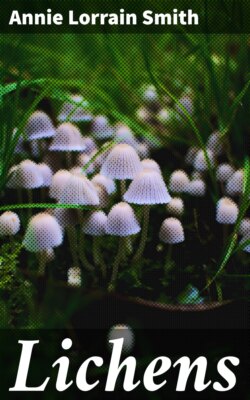Читать книгу Lichens - Annie Lorrain Smith - Страница 36
На сайте Литреса книга снята с продажи.
B. Development of lichenoid Hyphae
ОглавлениеLichen hyphae are usually thick-walled, thus differing from those of fungi generally, in which the membranes, as a rule, remain comparatively thin. This character was adduced by the so-called “autonomous” school as a proof of the fundamental distinction between the hyphal elements of the two groups of plants. It can, however, easily be observed that, in the early stages of germination, the lichen hyphae, as they issue from the spore, are thin-walled and exactly comparable with those of fungi. Growth is apical, and septation and branching arise exactly as in fungi, and, in certain circumstances, anastomosis takes place between converging filaments. But if algae are present in the culture the peculiar lichen characteristics very soon appear.
Bonnier[266], who made a large series of synthetic cultures, distinguishes three types of growth in lichenoid hyphae (Fig. 15):
1. Clasping filaments, repeatedly branched, which attach and surround the algae.
2. Filaments with rather short swollen cells which ultimately form the hyphal tissues of cortex and medulla.
3. Searching filaments which elongate towards the periphery and go to the encounter of new algae.
In five days after germination of the spores, the clasping hyphae had laid hold of the algae which meanwhile had increased by division; the swollen cells had begun to branch out and ten days later a differentiation of tissue was already apparent. The searching filaments had increased in number and length, and anastomosis between them had taken place when no further algae were encountered. The cell-walls of the swollen hyphae and their branches had begun to thicken and to become united to form a kind of cellular tissue or “paraplectenchyma[267].” At a later date, about a month after the sowing of the spores, there was a definite cellular cortex formed over the thallus. The hyphal cells are uninucleate, though in the medulla they may be 1-2-nucleate.
Fig. 15. Synthetic culture of Physcia parietina spores and Protococcus viridis five days after germination. s, lichen-spore; a, septate filaments; b, clasping filaments; c, searching filaments. × 500 (after Bonnier).
The hyphae in close contact with the gonidia remain thin-walled, and have been termed by Wainio[268] “meristematic.” They furnish the growing elements of the lichen either apical or intercalary. In most genera the organs of fructification take rise from them, or in their immediate neighbourhood, and isidia and soredia also originate from these gonidial hyphae.
As the filaments pass from the gonidial zone to other layers, the cell-walls become thicker with a consequent reduction of the cell-lumen, very noticeable in the pith, but carried to its furthest extent in the “decomposed” cortex where the cells in the degenerate tissue often become reduced to disconnected streaks indicating the cell-lumen, and the outer cortical layer is merely a continuous mass of mucilage.
All lichen tissues arise from the branching and septation of the hyphae, the septa always forming at right angles to the long axis of the filaments. There is no instance of longitudinal cell-division except in the spores of certain genera (Collema, Urceolaria, Polyblastia, etc.). The branching of the hypha is dichotomous or lateral, and very irregular. Frequent septation and coherent growth result in the formation of plectenchyma.
